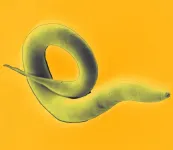(Press-News.org) UNIVERSITY PARK, Pa. -- The fast-moving decline and extinction of many species of detritivores -- organisms that break down and remove dead plant and animal matter -- may have dire consequences, an international team of scientists suggests in a new study.
The researchers observed a close relationship between detritivore diversity and plant litter decomposition in streams, noting that decomposition was highest in waters with the most species of detritivores -- including aquatic insects such as stoneflies, caddisflies, mayflies and craneflies, and crustaceans such as scuds and freshwater shrimp and crabs.
Decomposition is a biological process that's vital to life, explained study co-author Bradley Cardinale, professor and head of the Department of Ecosystem Science and Management, College of Agricultural Sciences, Penn State.
"The plant matter that doesn't get eaten by animals ultimately dies and must be recycled so that biologically essential nutrients are rereleased into the environment where they can be used again by plants," he said. "If that process of decomposition doesn't occur, or slows significantly, then life comes to a screeching halt. Phosphorus, nitrogen and other nutrients that we need as humans don't even exist in a biologically available form unless they get decomposed and recycled."
But all over the world, detritivore populations are dwindling and disappearing at an alarming rate -- a grim reality that spurred the study. There is good evidence that the rate of extinction for these organisms is 1,000 to 10,000 times faster than has occurred through the historic record, Cardinale pointed out.
"There has been a huge question about whether or not the diversity of these aquatic insects and crustaceans is crucial," Cardinale said. "If they go extinct, is this biological process of decomposition going to slow or not? We didn't have a good answer prior to this study. We didn't know if the extinction of these animals will greatly affect the ability of ecosystems to sustain life, or if other organisms such as bacteria and fungi will fill the ecological niche and accomplish a similar level of decomposition."
There are a number of causes of extinction, Cardinale said. In order of importance, they are habitat loss, overharvesting (which doesn't apply to this study), competition from invasive species, disease, pollution and climate change -- which he called "the big unknown at this point."
The study was global and uncommonly robust, involving 75 scientists analyzing decomposition in 38 headwater streams that were similar in size, depth and physical habitat across 23 countries on six continents. Most of the streams selected by the researchers had rocky substrate and were shaded by dense riparian vegetation.
At each site, the researchers incubated identical plant litter mixtures comprised of nine species collected at different locations around the world and distributed among study partners. Litter mixtures were enclosed within paired coarse-mesh and fine-mesh litterbags containing the same amount and type of litter.
"The two types of litterbags allowed us to quantify the amount of decomposition done by detritivores and by microbial organisms in the streams," Cardinale said. "We saw that in the litter enclosed by fine mesh bags that couldn't be accessed by aquatic insects or crustaceans, much less decomposition took place."
That indicates that bacteria and fungi alone likely can't accomplish the amount of decomposition needed in stream ecosystems, he added.
"When we excluded these animals, we saw a huge drop in decomposition rates, which means other organisms didn't compensate for them," Cardinale said. "When the detritivores were excluded, simulating extinction, we lost way more than 50% of the decomposition in the streams."
In findings recently published in Nature Communications, the researchers noted that streams with an abundance of detritivores had the highest rates of decomposition. They reported that the relationship between detritivore diversity and decomposition was stronger in tropical areas than in temperate areas and absent in boreal areas, and that abundance and biomass were important in temperate and boreal areas, but not in tropical areas.
According to the research team, the study results suggest that litter decomposition likely is being altered by detritivore extinctions and that these effects are particularly strong in tropical areas, where detritivore diversity already is relatively low and some environmental stressors are particularly prevalent.
Some of the study results are not surprising, Cardinale suggested. The abundance and size of detritivores are known to have a very strong impact on decomposition. So, streams that have more of them -- or that have larger invertebrates, such as big crabs and shrimp -- have more decomposition.
"But what was a surprise is that we also found that the diversity, the number of different species that were in streams, was one of the most dominant predictors of decomposition," he said. "And between abundance, body size and diversity, we could explain 82% of all of the global variation in decomposition. That means as these animals go extinct, we're going to lose the ability to decompose and recycle biologically essential materials that other organisms require for survival and growth."
INFORMATION:
Luz Boyero, research professor with the University of the Basque Country, Spain, was lead author of the study. Cardinale spearheaded the North American portion of the research.
The Basque Government in Spain funded this work.
ABINGTON, Pa. -- Counterfeit dominance decreases Anglo-American, but not Asian, consumers' quality perception and purchase intention of authentic brands, according to a team of researchers.
"Counterfeit dominance is the perception that counterfeit products possess more than 50% of market share," Lei Song, assistant professor of marketing at Penn State Abington, said. "Counterfeit dominance is a phenomenon especially concerning for the luxury fashion industry as counterfeit luxury fashion brands account for 60% to 70% of the $4.5 trillion in total counterfeit trade and one-quarter of total sales in luxury fashion goods."
Lei and his team conducted four behavioral experiments with 149 participants on ...
Increased labour mobility seems to have stopped the racial wage discrimination of black English football players. A new study in economics from Stockholm university and Université Paris-Saclay used data from the English Premier League to investigate the impact of the so-called "Bosman ruling", and found that racial discrimination against English football players disappeared - but not for non-EU players. The study was recently published in the journal European Economic Review.
In 1995, the so-called Bosman ruling turned the labour market for European footballers upside down, introducing a free transfer ...
Necessity is the father of invention, but where is its mother? According to a new study published in Science, fewer women hold biomedical patents, leading to a reduced number of patented technologies designed to address problems affecting women.
While there are well-known biases that limit the number of women in science and technology, the consequences extend beyond the gender gap in the labour market, say researchers from McGill University, Harvard Business School, and the Universidad de Navarra in Barcelona. Demographic inequities in who gets to invent lead to demographic inequities in who benefits from invention.
"Although the percentage of biomedical patents held by women has risen from 6.3% to 16.2% over the last three decades, ...
Researchers from Pompeu Fabra University (Barcelona, Spain) have analysed the way citizen science is practised in Spain. The paper, produced by Carolina Llorente and Gema Revuelta, from UPF's Science, Communication and Society Studies Centre (CCS-UPF) and Mar Carrió, from the University's Health Sciences Educational Research Group (GRECS), has been published in the Journal of Science Communication (JCOM).
Based on the study, a series of recommendations have been put forward to improve how citizen participation in science is carried out. Firstly, they suggest efforts be stepped up regarding the training given for assessing these initiatives or the creation of multi-disciplinary teams with a broad range of ...
Using an exceptionally preserved fossil from South Africa, a particle accelerator, and high-powered x-rays, an international team including a University of Minnesota researcher has discovered that not all dinosaurs breathed in the same way. The findings give scientists more insight into how a major group of dinosaurs, including well-known creatures like the triceratops and stegosaurus, evolved.
The study is published in eLife, a peer-reviewed open access scientific journal for the biomedical and life sciences.
Not all animals use the same techniques and organs to breathe. Humans expand and contract their ...
Researchers have shown how worms learn to optimise their foraging activity by switching their response to pheromones in the environment, according to a report published today in eLife.
The findings are an important advance in the field of animal behaviour, providing new insights on how sensory cues are integrated to facilitate foraging and navigation.
Foraging food is one of the most critical yet challenging activities for animals, with food often patchily distributed and other animals trying to find and consume the same resources.
An important consideration is how long to stay and exploit a food patch before moving on to find another. Leaving incurs the cost ...
Synthetic biology offers a way to engineer cells to perform novel functions, such as glowing with fluorescent light when they detect a certain chemical. Usually, this is done by altering cells so they express genes that can be triggered by a certain input.
However, there is often a long lag time between an event such as detecting a molecule and the resulting output, because of the time required for cells to transcribe and translate the necessary genes. MIT synthetic biologists have now developed an alternative approach to designing such circuits, which relies exclusively ...
AMHERST, Mass. - City sprawl and road development is increasingly fragmenting the habitats that many plant and animal species need to survive. Ecologists have long known than sustainable development requires attention to ecological connectivity - the ability to keep plant and wildlife populations intact and healthy, typically by preserving large tracts of land or creating habitat corridors for animals. New research from the University of Massachusetts Amherst argues that it's not enough for ecological modelling to focus on the landscape. If we want the best-possible ecological management, we should consider ...
DURHAM, N.C. -- Plant-based meat substitutes taste and chew remarkably similar to real beef, and the 13 items listed on their nutrition labels - vitamins, fats and protein -- make them seem essentially equivalent.
But a Duke University research team's deeper examination of the nutritional content of plant-based meat alternatives, using a sophisticated tool of the science known as 'metabolomics,' shows they're as different as plants and animals.
Meat-substitute manufacturers have gone to great lengths to make the plant-based product as meaty as possible, including adding leghemoglobin, an iron-carrying molecule from soy, and red beet, ...
Terence D. Capellini has been interested in how joints work for almost three decades. Part of it is due to personal experience, having sustained several joint injuries as a college ice hockey player and recently developing knee osteoarthritis. But the principal investigator of Harvard's Developmental and Evolutionary Genetics Lab has also seen the pain and limited mobility of loved ones who've received similar diagnoses and injuries.
"We have all these joints in the body and they don't look the same from one another," said Capellini, the Richard B. Wolf Associate Professor in the Department of Human Evolutionary ...


